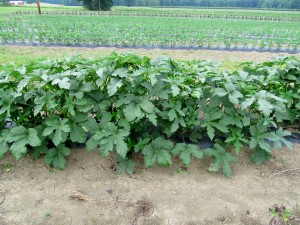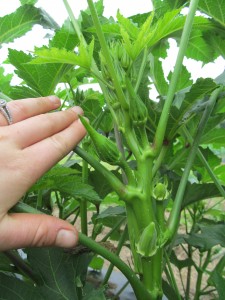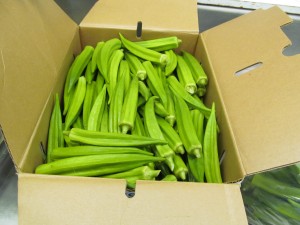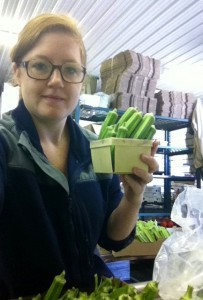Towards the end of my internship, I began working with Okra. Having no prior experience with okra, both eating or growing, I was quite excited to “meet” a new plant! I was lucky enough to have about sixty plants to work with. Twice a week, I harvested okra in the mornings right after all the dew evaporated.
Okra, Abelmoschus esculentus, is a heat loving southern staple crop. Okra is also synonymous with Ladies Fingers and gumbo. This plant does not tolerate frost or cold weather and must be planted after the last frost. Plants should have a roughly fifteen inch spacing and should not be transplanted.
Okra seed pods are actually what gets harvested. The plant will grow to a mature size and begin flowering. The flowers are actually in the hibiscus or mallow family. The flower themselves were a light yellow color with a striking burgundy bulls eye. After the flower is fertilized, the seed pod begins forming. We harvested seed pods roughly two inches or longer. Many times, we would get seed pods that were the size of bananas as opposed to the size of Jalapeno peppers.
Initially, I would daintily move the leaves of okra to find the seed pods. Yet, I found this to be inefficient because the green pods blend in with the green stems and foliage quite well. So, I would move the leaves and stems around with more gusto. I could harvest anywhere from a half peck of okra to two bushels of okra depending on the environmental conditions.
Another challenge with okra was dealing with the “hairs” on it. As I would move around the leaves, the trichomes would irritate my skin. If any okra breeder reads this blog, I would encourage breeding a variety with less trichomes or even better, a smooth plant! My final challenge with this southern beauty was keeping hold of the pods. Okra has a slimy texture when cooked and a slick texture when picked. By the tenth plant, my hands would be quite slick themselves!
I did try some raw, uncooked okra. Its texture was unique compared to all other plants, but reminded me of eating sea weed. I can understand why many people say the taste is acquired! Some customers couldn’t get enough okra while others were curious, but not adventurous with their taste buds. A fellow employee mentioned that in Mexico, okra is ground up and used like a coffee. This plant was memorable.





Speak Your Mind